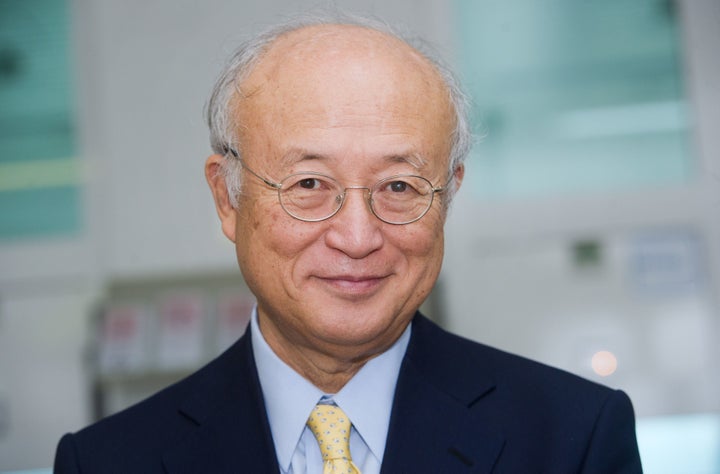
WASHINGTON -- A critical, cash-strapped U.N. agency has found itself in the middle of a game of diplomatic tug of war as lawmakers in Washington wrestle with the Iran nuclear deal.
The International Atomic Energy Agency, or IAEA, hasn’t captured as many headlines as other players in the negotiations. But if Congress approves the pact between Iran, the U.S. and five other world powers, the agency will be the one to check on whether Iran is fulfilling its obligations under the agreement, taking on a whole new set of verification and inspection requirements.
As skeptical legislators search for leverage in their fight against the nuclear deal, the IAEA has become a serious negotiating chip. A decent chunk of its funding comes from Washington and is beholden to fickle lawmakers -- some of whom have threatened to use that money to unspool the Iran agreement.
Earlier this month, Sen. Lindsey Graham vowed to hold up the agency's funding until lawmakers received access to additional documents from the Iran accord. Congress is set to vote on the deal framework next month.
IAEA's on-the-ground inspection teams will be the primary check on Tehran's nuclear ambitions. It's likely that only by its say-so would the world start tentatively lifting sanctions.
Money for those inspections comes from United Nations members' voluntary contributions. And a lot of that dough comes from the U.S. -- giving Congress, which has to sign off on most of America's U.N. contributions, a lot of leverage.
"The United States is committed to working with other IAEA member states to provide the agency the resources it needs to continue carrying out this [Joint Plan of Action]-related work," a State Department official told HuffPost, requesting anonymity in order to discuss the sensitive negotiations.
But regardless of the State Department’s intentions, Congress is the one that holds the pursestrings for U.S. contributions to the IAEA. While it’s unclear how much control legislators can exert over the IAEA’s spending, a big enough consort could keep U.S. funds from the pot.
A spokesman for the agency told HuffPost on Wednesday that "a meeting of the IAEA Board of Governors has been convened and is expected to take place on 25 August."
"It is expected that the Board will consider a report by the Director General on the requests in Security Council resolution 2231 and on the financial implications for the Agency," the spokesman continued, referring to the U.N. Security Council resolution that officially endorsed the Iran agreement.
Established in 1957, the IAEA is responsible for watching and maintaining nuclear security throughout the world. It's made up primarily of member states to the United Nations, and though technically separate from that international body, it reports to the U.N. General Assembly and Security Council.
The agency gets the funds to operate from member states' annual obligations. Programs get funded, but with hardly any wiggle room between the dollar signs when new or unexpected responsibilities arise. Budget trade-offs are a standard method of operation.
In previous years, tracking Iran's nuclear program ate up roughly 12 percent of the IAEA's 164 million euro inspection budget, which is part of the agency's relatively modest 500 million euro annual allocation. (That sum includes both regular contributions and additional, voluntary contributions from member states.) In addition to Iran, the IAEA is also tasked with monitoring the nuclear ambitions and safeguards of some 180 other countries, according to its latest annual report.
As recently as November, the IAEA told member states it required an additional 4.6 million euros to adequately keep tabs on Iran's facilities in accordance with the still-valid Joint Plan of Action. That plan, implemented at the beginning of last year, was an interim agreement to curb Iran's nuclear program while all sides continued to negotiate a final deal, and involved increased inspections of Iran's facilities by the IAEA.
Plenty of countries -- including those outside the P5+1 team, the group of world powers that is negotiating with Iran -- have pledged more money than the agency said it needed to continue running its inspections. As of February 2015, the IAEA had collected an additional 1.1 million euros.
"The December pledge by the United States was for 750,000 euros, in addition to the 850,000 euros that we had previously pledged for IAEA verification activities under the previous duration of the [Joint Plan of Action]," the State Department official added. "We strongly welcome the contributions already announced by some member states, and we hope others will join us in giving positive consideration to providing additional extra-budgetary contributions toward the IAEA's [Joint Plan of Action]-related efforts.”
If a deal is eventually finalized, the IAEA is very likely to require a bigger check than what the U.S. has already offered.
As a critical player in any successful deal with Iran, the IAEA's position at the negotiating table has its own potential complications. No one -- least of all the P5+1 negotiating partners -- want to let a lack of funding hinder its crucial inspections and verifications, so the agency's additional needs will likely be met. But the agency also could find itself in the crosshairs of those that want the deal to fail, since the success of any deal hinges on its performance.
"It's going to be a definite increase over what we're committing now," said Blaise Misztal, director of the Bipartisan Policy Center's Foreign Policy Project, where he has published several pieces on IAEA funding and the Iran deal.
The money isn't necessarily tough to get, he added. "Additional funding under the [Joint Plan of Action] was pretty easy to get for the IAEA. The P5+1 kicked in pretty quickly."
One potential hurdle is that the IAEA's budgetary needs seldom align with the budgetary deadlines of legislative bodies. The problem may not be whether the money is earmarked, Misztal said, but when it can be free of bureaucratic red tape.
"It can always be a concern," he said. "It wasn't part of [the IAEA's] regular budget." Instead, he added, budgetary needs could happen at six-month or four-month intervals.
This story has been updated to include comment from an IAEA spokesman.
